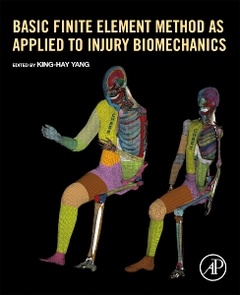Basic Finite Element Method as Applied to Injury Biomechanics
Auteur : Yang King-Hay

Basic Finite Element Method as Applied to Injury Biomechanics provides a unique introduction to finite element methods. Unlike other books on the topic, this comprehensive reference teaches readers to develop a finite element model from the beginning, including all the appropriate theories that are needed throughout the model development process.
In addition, the book focuses on how to apply material properties and loading conditions to the model, how to arrange the information in the order of head, neck, upper torso and upper extremity, lower torso and pelvis and lower extremity. The book covers scaling from one body size to the other, parametric modeling and joint positioning, and is an ideal text for teaching, further reading and for its unique application to injury biomechanics.
With over 25 years of experience of developing finite element models, the author's experience with tissue level injury threshold instead of external loading conditions provides a guide to the "do?s and dont's" of using finite element method to study injury biomechanics.
1. Introduction2. Meshing, Element Types, and Element Shape Functions3. Isoparametric Formulation and Mesh Quality4. Element Stiffness Matrix5. Material Laws and Properties6. Boundary and loading conditions7. Stepping through finite element analysis8. Modal and Transient Dynamic Solutions9. Biological Components Modeling10. Parametric Modeling11. Modeling passive and active muscle12. Modeling the Head13. Modeling the Neck14. Modeling the Upper Torso and Upper Extremity15. Modeling the Lower Torso16. Modeling the Lower Extremity17. Modeling Vulnerable subjects18. Fundamentals of Blast Modeling
Biomedical Engineers, Biomechanical Engineers, Graduate Students, Clinicians, R&D Professionals, Mechanical Engineers, Material Scientists.
Dr. Yang’s research interests include injury biomechanics, contact impact biomechanics, and bone fracture biomechanics. His most recent research involves detailed modeling of the human body from head to toe in efforts to investigate mechanisms of injury related to motor vehicle collisions, contact sports, and blast-induced injuries. His team developed a human brain model that is now on a permanent display at the Computer World of the Smithsonian Institution.
Dr. Yang received the 1984 Volvo award in Biomechanics, The Creators: Metro Detroit’s Inventors award by Crane’s Detroit Business; the Best Biomechanics Paper Award of the 2001 International Congress on Whiplash Associated Disorders; the 2001, 2007, and 2008 John Paul Stapp Best Paper Awards; and the 2009 Ralph H. Isbrandt Award for the best paper in automotive safety at the Society of Automotive Engineers (SAE) World Congress. He is a Fellow of the American Institute for Medicine and Biological Engineering (AIMBE) and a Fellow of SAE. He has served as a Visiting Professors at the Swiss Federal Institute of Technology in Zurich, Switzerland, in 1994; Monash University in Melbourne, Australia from 2001 to 2007; the National Cheng-Kung University in Tainan, Taiwan in 2003; the Honk Kong Polytech University in Kowloon, Hong Kong, in 2005; and the Taipei Medical University in 2011. He has also been a Chang-Jiang (Yangtze River) Professor of Hunan University in Changsha, Hunan, China since 2005.
- Covers the fundamentals and applications of the finite element method in injury biomechanics
- Teaches readers model development through a hands-on approach that is ideal for students and researchers
- Includes different modeling schemes used to model different parts of the body, including related constitutive laws and associated material properties
Date de parution : 09-2017
Ouvrage de 748 p.
19x23.3 cm
Thèmes de Basic Finite Element Method as Applied to Injury... :
Mots-clés :
[B] matrix; 3D CAD surface generation; Abdomen FE model; Active muscle; Age-specific FE model; ALE; Aorta rupture; Blast wave; Brain material model; Cadaver tests; Computational neck model; Constitutive equation; Continuity; Coordinate transformation; Cortical rib thickness; Discretization; Elastic-plastic; Elderly female; Equation of state; Essential boundary condition; Explicit integration method; Facet-joint angle; Finite element method; Finite element; Fluid-solid coupling; Gauss quadrature; Gender-specific FE model; Head model; Heidelberg-type sled; Hyperelastic; Image registration; Impacts; Implicit integration method; Initial condition; Injury biomechanics; Injury mechanism; Injury; Isoparametric formulation; Iterative procedures; Jacobian; Kidney; Kinematic response; Linear elastic; Liver; Lower extremity; Matrix structural analysis; Medical application; Mesh morphing; Mesh quality; Mesh; Modal analysis; Model validation; Multiblock technique; Muscle activity; Musculature; Natural boundary condition; Natural coordinate system; Neck anatomy; Normal and shear strains; Orthotropic; Parametric human model; Passive muscle; Pediatric safety; Penalty method; Principal stress; Real-world accidents; Responsible variables; Segmentation; Shape functions; Spine; Spleen; Statistical human geometry model; Strong formulation; Superposition; Thorax FE model; Transient dynamic analysis; Traumatic brain injury; Upper extremity; Validation; Verification; Viscoelastic; Von Mises stress; Voxel-based meshing; Vulnerable population; Wave propagation; Weak formulation



